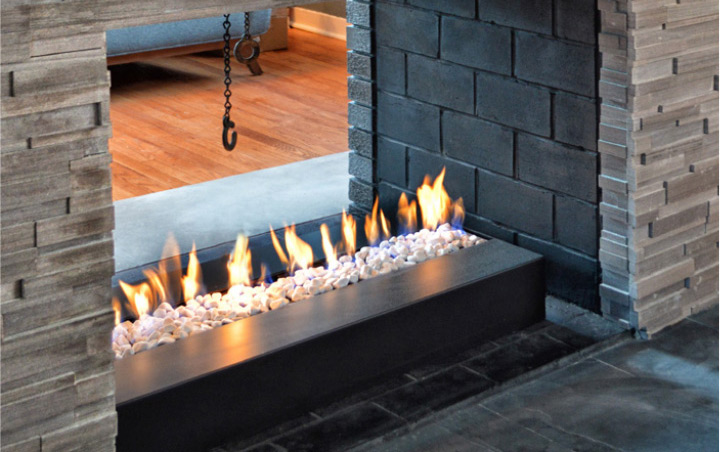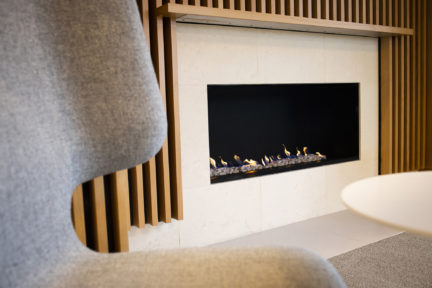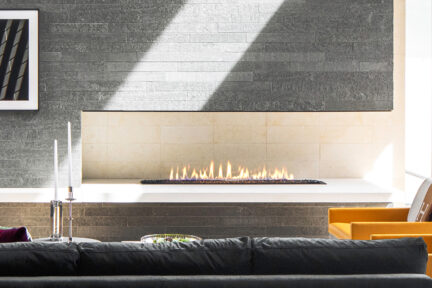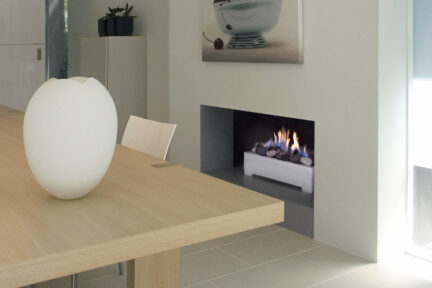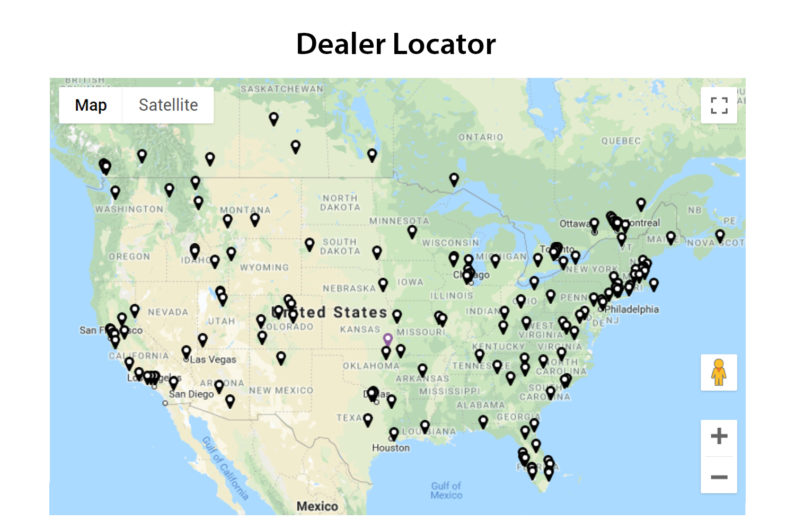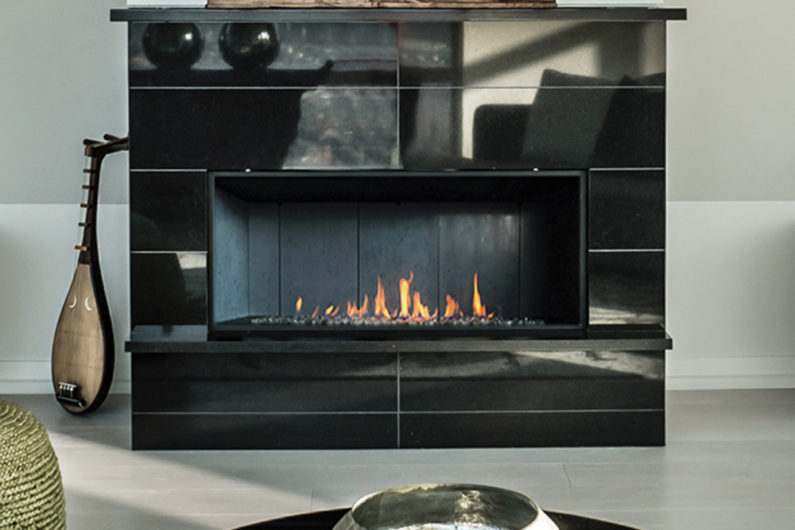Browse our entire line of gas fireplaces below. Choose from a multitude of styles: single-sided, see-through, corner, 3 sided, and peninsula modern gas fireplaces. Our fireplaces are designed and fabricated in New England.
European Home Fireplaces
Filter by:
Size
Configuration
Fuel
Burner
Model
Location
Vent
Optional Features
Unfortunately, we don't have a matching fireplace for the criteria you've selected. If you'd like help with choosing a fireplace, please contact us.
A living history.
By no surprise, the foundation of European Home dates back to founder Holly Markham’s years spent digesting European architecture and design during the early 1990s. While living in Germany and traveling extensively throughout Central Europe and Scandinavia she developed a passion for clean contemporary styling mixed with timeless architecture. There is a beautiful moment in design when contrasting elements come together in perfect harmony. Holly realized that if it can happen on the streets of Munich; it can happen in your living room as well.
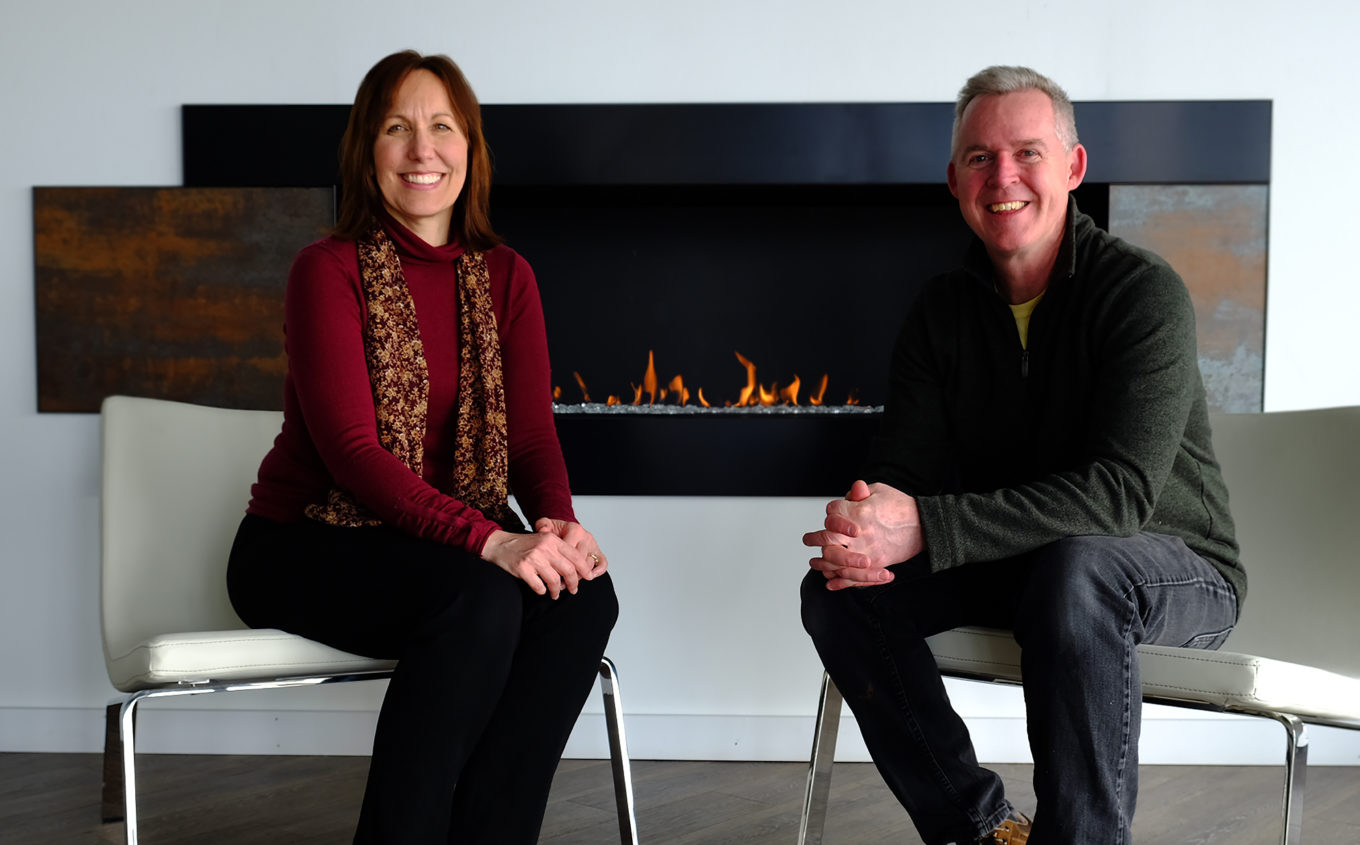
Holly and John Markham, Co-Founders of European Home.
In the wild.
Find a Local Fireplace Professional Today
There is just no substitute for a true professional. All of our authorized fireplace dealers are not only trained in our products but can help you with local building codes and ensure a safe and professional fireplace installation. Use our Dealer Locator tool to find a Fireplace Professional near you.
What’s new.
Vent Free Gas Fireplaces: Are They Safe?
They’ve been around for almost 40 years now, but vent free gas fireplaces are still viewed skeptically in the public domain. In a sense, they are the victims of their own success. As their sales numbers have ticked up year after year, the questions about their indoor air quality impact get magnified, especially in the […]
About Ventless Gas Fireplaces
Building a luxury home is the perfect way to make sure that your home matches your exact preferences and specifications. One appliance that can provide the interiors of your home with a style and luxury appearance is a fireplace. At European Home, we offer a wide selection of premium fireplaces that are made with the best materials as well as the most advanced technology. One type of fireplace you can choose for your new home is a ventless gas fireplace, which offers some distinct advantages over other types. The following is a comprehensive guide on ventless gas fireplaces and why you should consider one for your home.
What Are Ventless Gas Fireplaces?
A ventless gas fireplace is very much as described: it has been designed to burn without the need for venting. Unlike a direct vent fireplace, which vents to the outside and brings in combustion air to a sealed firebox, a ventless gas fireplace uses available room air to provide the oxygen necessary for combustion.
A ventless gas fireplace can be operated with natural gas. This gas will flow directly into a gas burner that’s situated on top of the fireplace. Once the fireplace has been ignited, all the flames produced in the unit will run into the gaps of artificial logs.
Because of how ventless gas fireplaces work, they can burn gas at a more efficient rate when compared to vented fireplaces. By burning gas more efficiently, less fumes are produced, which means that a chimney isn’t needed.
Are Ventless Gas Fireplaces Safe?
Even though ventless gas fireplaces have been in existence for decades, there are still discussions and debates going on about how safe these fireplaces are. Using this type of fireplace is not certified in California and certain municipalities because of the belief that it can pose a problem when installed in residential homes.
Now, nearly 20 states allow ventless gas fireplaces without any kind of restrictions in place. The restrictions differ with each state and district. While some states control where a ventless gas fireplace can be installed in a home, other states limit the legality of these fireplaces to cities with low populations.
A primary concern with ventless gas fireplaces is that oxygen levels could drop to low levels that may be dangerous for any home that isn’t well-ventilated. European Home ventless gas fireplaces mitigate this issue with the inclusion of an effective oxygen detection sensor. When the oxygen detection sensor is in place, the unit will be turned off immediately if ever oxygen falls below acceptable levels. As for carbon monoxide detectors, these components can also shut off the fireplace if carbon monoxide is detected at a high level.
The Pros and Cons of having a Ventless Gas Fireplace
Just like every type of fireplace, there are pros and cons of having a ventless gas fireplace installed in your home. If you’re wondering if ventless gas fireplaces make sense for you, the answer to this question largely depends on what you want out of a fireplace. The main benefits of a ventless gas fireplace include:
- Ventless gas fireplaces don’t produce any ash or soot.
- Since a flue isn’t required for a ventless gas fireplace, heat won’t escape while the fireplace is being used. As such, your gas utility bills should be effectively reduced.
- Because there is no outside venting you can choose to place a ventless gas fireplace in almost any room throughout your home.
- Ventless gas fireplaces can also be installed in condos and small homes.
- Having a ventless gas fireplace installed is considerably more affordable than the alternative.
- The flames from a ventless gas fireplace look and feel like the ones that come from a vented fireplace.
While there are many benefits derived from having a ventless gas fireplace installed in your home, there are also some issues that you should be aware of. A few downsides to obtaining a ventless gas fireplace include:
- The gas combustion process results in the production of a small amount of water vapor, which can make your home feel humid in a humid climate.
- Even though ventless gas fireplaces don’t produce as many fumes as vented ones, it’s important to understand that some fumes can still enter your home.
- Ventless gas fireplaces aren’t allowed in some municipalities. Consult your fireplaces dealer to see if a ventless unit is allowed in your area.
Weigh the pros and cons before deciding if a ventless gas fireplace is right for you and your home.
Can You Have a Gas Fireplace Without a Vent?
A ventless gas fireplace makes it possible to have a gas fireplace installed in your home even if you don’t have a vent. These fireplaces consist of a U-shaped path that allows the system to properly function. When you have a ventless gas fireplace installed in your home, it will take oxygen from the room and into the lowermost portion of the fireplace. A regulator inside the fireplace will then mix the air directly with gas to produce fire.
How Long Can You Run Ventless Gas Fireplaces?
As is the case with any type of fireplace, you shouldn’t run a ventless gas fireplace for a lengthy period. Because ventless gas fireplaces produce a small number of fumes that will invariably enter the air in your home, keeping the fireplace on for too long could result in an increase of carbon monoxide levels in a home.
Most experts state that a ventless gas fireplace should only remain in operation for right around three hours before you shut it off for a while. You might even want to reduce this time to two hours to be certain that the air quality in your home will remain high. Consider asking the manufacturer of your specific ventless gas fireplace how long the fireplace should be kept on. Taking these steps now will allow you to safely operate the fireplace in the future.
Can You Put a TV Above Ventless Gas Fireplaces?
As long as you follow recommended installment guidelines, you should be able to place a TV above your ventless gas fireplace. However, this kind of setup can be risky to the condition of your TV set. Before you place a television set above your ventless gas fireplace, it’s important to understand that any fireplace generates a considerable amount of heat. Regardless of the type of fireplace you have, the hottest area surrounding a fireplace is the area just above it.
In most cases, electronics don’t perform particularly well when exposed to high heat on a long-term basis. While your TV will likely work after you position it above your fireplace, this may only be temporary. Over time, it’s possible that your television would malfunction because of consistent exposure to high heat. You can mitigate these issues by taking the necessary precautions.
European Home offers some intuitive design options to prevent this from happening in our Cool Wall Installation Guide for TV Mounting document.
The most important consideration when placing a television set above a fireplace is to do so at the right height. If you position the TV at around 12 inches above your fireplace or mantle, the heat that’s produced from the fireplace shouldn’t adversely affect the quality of your TV.
Do Ventless Gas Fireplaces Smell?
You should expect an odor to accompany your ventless gas fireplace whenever it’s in operation. In fact, it’s impossible to take measures to prevent this odor because of how a ventless gas fireplace is constructed. Since these fireplaces don’t vent fumes out of a chimney, the small number of fumes that are created by the fireplace will get into the indoor air throughout your home. Most people are not bothered by the odor. It is a good idea to visit your local fireplace dealer for a demonstration.
The carbon dioxide and water vapor in natural gas don’t have an odor to them. However, other byproducts are produced during combustion that creates an odor, which can smell like burning gas. However, it shouldn’t be too strong. If you want to reduce the strength of this odor, you should open some windows in your home, which will let in fresh air to improve your home’s indoor air quality. If you’ve already had a ventless gas fireplace installed and don’t like the smell that accompanies it.
Do Natural Gas Stones Need a Vent?
Natural gas stones are available as vented and ventless gas stones, which makes it possible to use gas stones without having a vent. Ventless gas stones are exceedingly efficient, which allows them to provide your home with ample amounts of heat without creating too many dangerous fumes that need to be vented. The base design of ventless gas stones allows it to create a clean flame that doesn’t produce smoke.
Because of how hot these stones get hot, almost all the fuel that you use will be combusted. While there are some differences between vented and ventless gas stones, ventless stones provide a somewhat natural appearance without requiring you to completely redesign your home. If you’re building a home from scratch, you can choose from among many different types of fireplaces.
What Is the Difference Between Vented and Ventless Gas Stones?
Before you decide to have a ventless gas fireplace insert installed in your home, you should know more about the difference between vented and ventless gas stones. Vented gas stones provide the kind of aesthetics and ambiance that are typically only available with wood-burning fireplaces. If you want a gas fire that appears as realistic as possible, vented gas stones can provide you with the desired appearance.
These stones are usually outfitted with premium ember beds that provide that warm glow that wood-burning fireplaces have when a fire is about to die. The primary issue with using vented gas stones is that they aren’t as efficient as their ventless counterparts. When you use vented gas stones, a chimney is necessary. You will also need to keep the chimney damper open constantly when the vented gas stones are in use. Because the damper remains open, a considerable amount of heat generated from the fireplace will be lost.
As for ventless gas stones, these stones are highly efficient and can provide your home with a substantial amount of heat. Because these gas stones don’t need to be vented, none of the heat produced by the fire is lost. The main downside to using ventless gas stones is that the flames produced from these logs typically have a bluish hue to them. It’s also important to stack the stones around the gas outlets, which can adversely affect the natural appearance of the fire. If heat is the primary reason you want to have a fireplace installed in your home, you can’t go wrong with ventless gas stones.
Is It OK to Leave Gas Fireplaces on Overnight?
You should never leave your gas fireplace on overnight because of the risk of carbon monoxide poisoning. While most ventless gas fireplaces are designed to shut off if too much carbon monoxide enters the surrounding air, there’s always a possibility that the monitoring system is malfunctioning, which is why it’s better to be cautious when using a ventless gas fireplace.
Is It OK to Leave the Pilot Light on in Gas Fireplaces?
You should be able to leave the pilot on in your gas fireplace without worrying about potential safety issues.
Ventless gas fireplaces offer tangible benefits that are difficult to find with other options at your disposal. Since this type of fireplace doesn’t need to be vented, maintaining the heat is considerably easier when compared to vented fireplaces of all kinds. Whether you’re in the market for a gas fireplace or wood fireplace, we’ve got you covered. At European Home, we offer luxurious modern fireplaces that are made with the most stylish designs.
If you have any questions about ventless gas fireplaces
or need help finding a local dealer.

